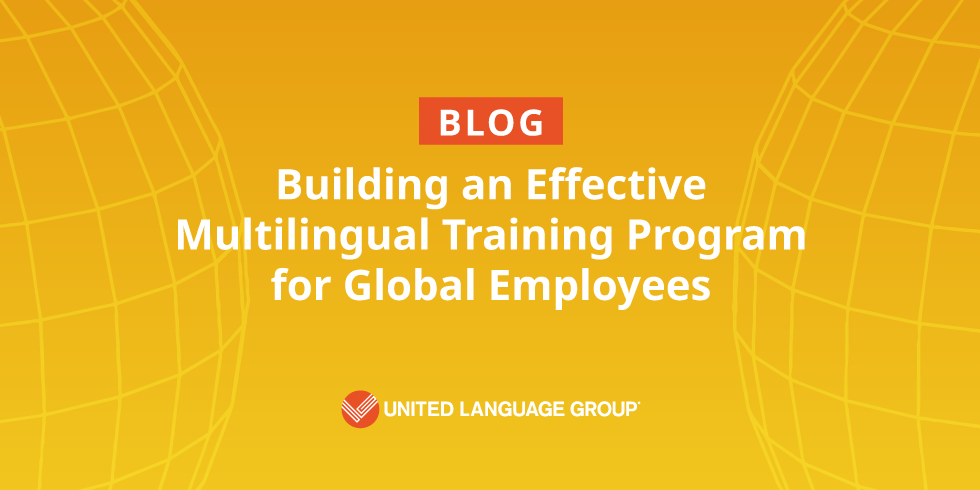In today’s online and connected world, more companies than ever rely on global teams. This business model offers several advantages, including the ability to recruit top talent worldwide, gain local expertise, and lower operational costs. Yet it’s not without challenges. Global employees speak different languages and have diverse cultural norms when it comes to workplace communication and expectations.
To be successful global companies need to train these employees so they can collaborate effectively, be productive, comply with local regulations, and gain the skills necessary to do their jobs.
Translation is a start, yet multilingual corporate training programs must go beyond that to be truly effective. Let’s look at why localizing your training programs is important, then get into the challenges and how to approach them
How eLearning Localization Improves Your Global Training Program
First, localized training programs improve business results and employee retention.
For example, European Commission research found that learners who have access to localized content understand and retain 50 percent more information compared to non-localized content. As a result, employees are more engaged and confident in their work, leading to increased productivity.
Localized training further enhances employee retention, performance, and engagement because learning experiences are tailored to the specific needs and culture of each learner. Localized elearning also promotes community, a sense of belonging, and increases staying power through connection and engagement.
Beyond eLearning Translation: The Challenges of Training a Global Workforce
Before we dive into eLearning translation best practices, let’s explore some of the most common challenges.
Language barriers
Employees perform better when they have training materials in their own language. However, translations need to be accurate, culturally appropriate, and easy to understand. Language mismatches or inadequate translations may cause confusion, disengagement, and decrease retention.
Cultural differences
Communication norms and preferences vary across cultures. In fact, cultural norms can play as big of a role as language. For instance, direct feedback cultures express criticism openly and bluntly, while indirect feedback cultures express criticism softly and diplomatically. In her book The Culture Map, author Erin Myer compares German and Indian communicators to highlight the difference. Germans are direct feedback givers who value honesty and improvement, while Indians are indirect feedback givers who value respect and face-saving.
Learning styles
Different cultures may prefer different learning methods. Some cultures might value interactive group discussions and collaborative activities, while others might emphasize individual reflection and self-paced learning.
Developing Your eLearning Localization Strategy
First, you need to understand and be able to apply the Cultural Drivers of Engagement (CDE) of each audience when you are building training programs. These are factors within a culture that affect how team members engage with your eLearning content, such as their demographics, values, and beliefs. When you apply a CDE framework, you’ll develop training programs that are relevant and engaging for people from that cultural background. This is the optimal way to create training programs, but if you have a diverse group representing multiple cultures, it will be hard to create one program that fits them all.
With all this in mind, how do you localize an existing training program? Here are two ways to do it:
- Create global content and then localize it into all your languages. The content will be more generic, but you'll have basic training that's 'good' for everyone.
- Adapt the home market training programs for each market, a process called transcreation.
Regardless, you need to make sure your content is relevant, targeted, and takes cultural nuance into account.
Five tips for eLearning content localization
Simply put, localized training is about much more than translation. It’s about:
- Learning styles of that culture
- Culture preferences such as levels of formality, how feedback is given
- Images and graphics
- Music and soundtracks
- Exercises and activities that require customization
Since that’s a lot to consider, here are five tips to help you get started:
- Create curriculum that respects all cultures, if it can’t represent each uniquely.
- Plan eLearning localization from the start. Consider using universal graphics, fonts, and examples to minimize the number of changes.
- Create a responsive design. Optimize the content layout for different languages, considering text expansion or contraction.
- Research local regulations. Be sure your eLearning courses meet local privacy and security laws, like the GDPR.
- Partner with an eLearning localization provider. Choose a company that understands your industry, target language(s), and local culture(s).
How ULG Can Help
We deliver tailored eLearning solutions to adapt all your training materials—from employee handbook translation to online courses. But don’t take our word for it. Check out our case studies to see for yourself. We’ve localized:
- Children’s education initiatives into six languages for a global IT company within a two-week deadline.
- Company-wide training into 11 languages for a healthcare manufacturer, resulting in 20 percent savings in both time and associated costs.
- Twenty-four eLearning videos into 12 languages for a multinational life sciences company, delivering the project five days ahead of schedule.
Over the past 35 years, we’ve helped the world’s biggest brands scale multilingual training initiatives with an award-winning team of eLearning translators. With our industry-specific linguists, advanced language technology, and project management expertise, you’re a click away from success. Connect with us to build your multilingual training program.

